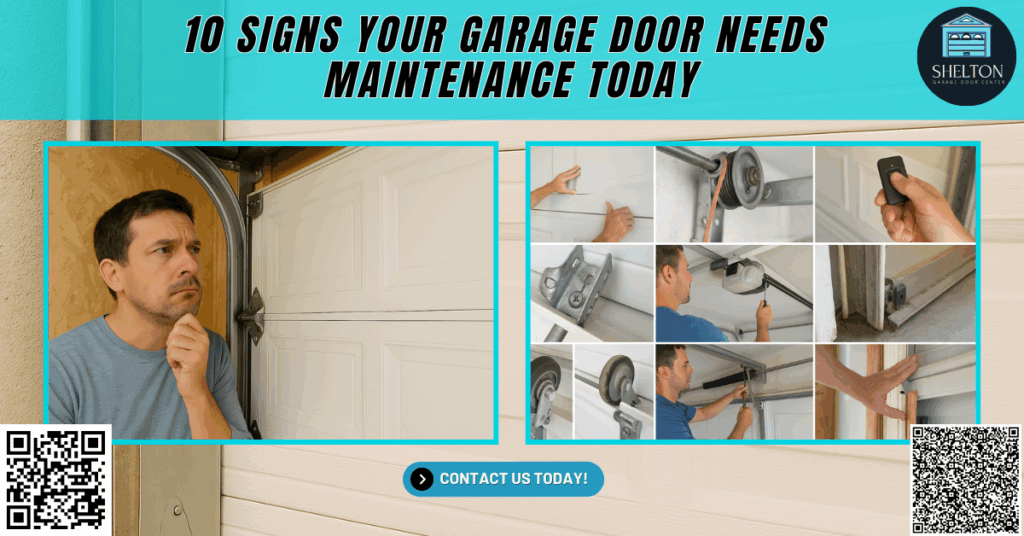When Tom and Lisa from Ansonia noticed their garage door groaning louder each morning, they thought it was just getting old. But one Monday, the door froze halfway, trapping their car inside and making them late for work. When our technicians arrived, they found dry garage door rollers, worn torsion springs, and misaligned garage door tracks, issues that could have been prevented with regular maintenance. Timely service not only saves you time and money but also protects your home, your garage, and most importantly, your family.
According to the U.S. Consumer Product Safety Commission, garage doors account for around 20,000 injuries annually. From faulty garage door openers to snapping springs and corroded metal parts, most of these accidents happen because homeowners don’t realize how crucial garage door maintenance is. Just like a car needs oil changes, your garage door system requires lubrication, alignment, and safety checks to ensure safe, quiet operation every time.
At Shelton Garage Door Center, we believe maintenance isn’t just about avoiding breakdowns. It’s about taking proactive steps to ensure your door, your garage, and the people who rely on them are protected. Whether you have steel doors, wood doors, or an automatic opener like a Stealth Drive Connect, here are the top 10 signs your garage door needs immediate attention.
1. Unusual Noises During Operation
When your garage door starts making grinding, screeching, or banging noises, it’s more than just annoying. It’s a red flag. These sounds often indicate that key garage door parts such as rollers, hinges, or torsion springs are wearing out. A noisy door is usually caused by a lack of proper lubrication or the accumulation of debris along the tracks and moving parts. Regularly applying a high-quality spray lubricant like white lithium grease to the hinges, springs, and rollers can significantly reduce these sounds and extend the life of your door.
Unusual noises might also indicate that the garage door opener is under strain or that the door is out of alignment. Over time, these minor issues can lead to more severe damage, like worn gears or misaligned tracks. Performing regular maintenance tasks like tightening bolts, cleaning the tracks, and lubricating moving parts will ensure that your door operates with quiet efficiency. Don’t ignore these sounds, they’re your door’s way of asking for help.
2. Slow or Jerky Movement
A garage door that moves slowly, hesitates, or jerks during operation is often struggling against worn or misaligned components. This can result from aging torsion springs, damaged rollers, or debris clogging the garage door tracks. Uneven movement adds stress to your garage door opener and can shorten the lifespan of your garage door system significantly.
Jerky or delayed movement can also indicate a problem with the garage door sensors or a failing automatic opener. This inconsistency not only affects performance but could also pose safety risks, especially if the door stops unexpectedly while closing. Routine inspections will help detect signs of wear in the rollers, cables, or spring tension. Make it a yearly habit to service these components to ensure smooth, quiet operation throughout all seasons.
3. Door Doesn’t Open or Close Fully
When your garage door stops short of fully opening or closing, it’s more than just an inconvenience. It could be a sign of sensor misalignment, worn springs, or a failing automatic opener. A partially closed garage door compromises home security and leaves your garage vulnerable to weather damage and pests.
The first step is to inspect the garage door sensors for dust or debris. A quick cleaning with a soft cloth may resolve the problem, but if not, a trained technician should evaluate the system. Mechanical problems like frayed cables, misaligned tracks, or broken torsion springs could be behind the incomplete motion. Timely professional service and annual tune-ups can help identify and fix these problems before they lead to more serious door failures.
4. Uneven or Sagging Door Panels
If your garage door panels don’t sit evenly when closed, or if you notice sagging sections, it’s a clear indication of imbalanced tension or damaged components. Sagging panels are often a result of worn springs or uneven pressure from the cables. Over time, this imbalance can place added strain on your garage door opener and lead to costly repairs.
Leaving a door in this condition can cause long-term warping, especially with wood doors exposed to Connecticut’s changing weather. Steel doors may begin to rust around stress points, and weakened hinges can loosen over time. Regular inspections should include checking the level of the door and inspecting the arm bar, hinges, and roller brackets. If your door doesn’t sit flat on the garage floor, it’s time for a professional evaluation and rebalancing.
5. Worn or Broken Springs
Garage door springs play a critical role in lifting and lowering your door. Whether you have extension springs or torsion springs, these parts are under constant tension and require annual inspection. A snapping sound or an inability to open the door fully can mean a spring has broken, a situation that can be dangerous if not handled correctly.
Springs should never be adjusted or replaced by anyone other than a trained garage door professional due to the high tension they carry. When springs wear out, your door may become too heavy for the opener to lift, leading to motor damage. Applying white lithium grease and checking the spring balance is essential maintenance. Keeping an eye on how the door moves and listening for unusual sounds can help catch spring issues before they become emergencies.
6. Drafts, Energy Loss, or Increased Bills
Have you noticed your garage feels too hot in summer or freezing in winter? This may be a sign that your weatherstripping is cracked or the bottom seal is damaged. Damaged seals and poor insulation result in drafts and increased energy bills, especially if your garage is attached to your home.
Over time, exposure to weather can cause rubber seals to become brittle and ineffective. Replacing damaged weatherstripping, sealing gaps, and installing insulation panels can significantly improve your garage’s energy efficiency. This not only protects your tools and stored items from extreme temperatures but also saves money on heating and cooling bills. Annual inspections of the door’s perimeter can help catch these issues early and ensure your garage remains weather-tight.
7. Remote Control or Keypad Malfunctions
If your garage door remote or wall-mounted keypad suddenly stops working, the issue may extend beyond dead batteries. These problems are often linked to faulty sensors, loose wiring, or even interference from nearby electronics. In many cases, recalibrating your opener or reprogramming your remote can resolve the issue.
Intermittent connectivity or delayed response can signal a weakening signal or a malfunctioning receiver in your garage door opener. Check the opener’s antenna for damage, and make sure no obstructions are interfering with signal transmission. For best results, test your remote and keypad multiple times at different times of the day. If issues persist, our service team can perform a comprehensive diagnostic to pinpoint the exact cause and restore reliable access.
8. Door Reverses Unexpectedly
A garage door that reverses before hitting the ground often points to sensor problems or resistance along the tracks. This safety feature, known as the auto-reverse feature, is designed to prevent accidents, but false triggers can be caused by misaligned sensors, obstructions, or damaged garage door rollers.
Even a spider web or clump of dust can throw off the sensor alignment, causing the door to reverse unexpectedly. Test the auto-reverse feature monthly by placing an object in the door’s path to ensure it reacts properly. If the door closes partway and then reopens, you may need a sensor realignment or opener recalibration. Keeping the tracks clean and free of debris also minimizes the chance of the door reversing unnecessarily.
9. Visible Rust, Corrosion, or Physical Damage
If you spot rust spots, cracked hinges, or frayed cables, these are all signs that your garage door system is deteriorating. Exposure to water, snow, and salt can cause corrosion on metal parts, especially the tracks and springs. Wood doors, meanwhile, may show signs of water damage or warping.
Routinely cleaning the garage door and inspecting all hardware can help prevent rust and corrosion. Apply a corrosion-resistant spray to metal surfaces and make sure to use white lithium grease on hinges and rollers to reduce friction. Loose bolts and nuts should be tightened using a socket wrench, and worn bearings should be replaced promptly. Regularly checking the structural integrity of your garage door will preserve both safety and appearance.
10. It’s Been Over a Year Since Your Last Maintenance Check
The most overlooked sign that your garage door needs maintenance is simply the passage of time. If it’s been over a year since a professional inspected your system, you’re overdue for service. Like any mechanical system with moving parts, garage doors require annual maintenance to stay safe and functional.
Scheduled maintenance should include lubrication, checking for debris in the tracks, verifying sensor function, and tightening all hardware. A technician will inspect every part of your garage door system, from the torsion springs and rollers to the opener’s arm bar and top rail. Preventative maintenance ensures your garage door operates efficiently and helps prevent inconvenient breakdowns. Don’t wait for something to go wrong, make it a yearly tradition to have your door inspected.
Final Thoughts
Garage doors are one of the most frequently used entry points in any home, yet they’re often the most neglected. From keeping your family safe to protecting your home and improving energy efficiency, regular garage door maintenance is essential. Simple steps like lubricating rollers, checking hinges, and cleaning debris from tracks can add years to your door’s lifespan.
Performing these tasks consistently ensures safe operation and reduces the likelihood of sudden breakdowns. Taking time to examine your door’s features, test safety sensors, and listen for strange noises are easy ways to catch small issues early. A well-maintained garage door not only provides reliable service but also adds curb appeal and value to your home. If you’re ever unsure about what to look for, reach out to a professional for a detailed inspection.
How Can Shelton Garage Door Center Help You?
As your trusted provider for garage door repair, maintenance, and installation in Ansonia and surrounding areas, Shelton Garage Door Center is here to serve.
We provide:
- Annual garage door maintenance plans
- Emergency garage door repairs and service calls
- Garage door opener installation and calibration
- Weatherproofing and energy efficiency upgrades
- Torsion spring, cable, and roller replacements
- Full inspections with step-by-step guidance
- Custom solutions for residential and commercial garage doors
Our trained technicians use high-quality tools and follow best practices recommended by professionals like Family Handyman and industry guides. Whether you have questions about the right lubricant, need help choosing between steel or wood doors, or want to explore smart features for your door opener, we have you covered.
Don’t wait for your garage door to fail. Take the first step toward safety and reliability today.
Shelton Garage Door Center
20 Waterview Dr, Shelton, CT 06484
Phone: (203) 718-5976
Call now to schedule your service or inspection appointment.
Frequently Asked Questions (FAQs)
Q1: How often should I lubricate my garage door parts?
You should lubricate all moving metal parts, such as hinges, rollers, and springs, every six months with a spray lubricant like white lithium grease.
Q2: Can I use WD-40 to lubricate my garage door?
No, WD-40 is a cleaner and degreaser, not a lubricant. Use white lithium grease or a silicone-based spray designed for garage door systems.
Q3: What is the lifespan of a typical garage door spring?
Most torsion springs last about 7 to 10 years or 10,000 cycles, depending on usage and maintenance.
Q4: Why is my garage door opener beeping?
Some garage door openers beep to indicate a low backup battery, programming issue, or maintenance alert. Check the manual or call a technician for inspection.

